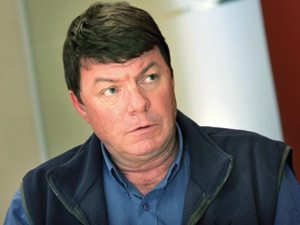
[miningmx.com] – Harmony today unveiled a radically changed prefeasibility study (PFS) for development of its Golpu copper/gold project in Papua New Guinea (PNG) in which the estimated capital cost has been slashed to build a smaller mine with higher profit margins.
Yet Harmony shares failed to react on the JSE and dipped about 2% to trade around R19.50 despite the assessment by CEO Graham Briggs that forecast profit margins on the mine – which should start production in 2020 and reach steady-state output in 2024 – were ” mouth watering’.
Reasons appear to be analyst concerns over the possible financial impact on the group of further erratic performances from its South African mines – in particular Kusasalethu – combined with continued scepticism over the group’s ability to afford the PNG development.
Such fears were rejected by Briggs and Harmony financial director Frank Abbott at a presentation in Sandton.
Abbott pointed out that Harmony’s capital commitments to Golpu would be limited through to the group’s 2017 financial year and Harmony would be able to fund them from internal cash flows “as we have been doing for the last number of years at these levels or greater’.
From financial year 2018 until financial year 2020 Abbott said Harmony would look at using a combination of internal cash flows; project finance and “copper funding’ – loans made available from copper consumers keen to secure future supplies.
The revised project is expected to be cash positive after capital expenditure from financial year 2021.
“We not foresee a problem with funding,’ Abbott stated.
In a research report published on December 2, JP Morgan Cazenove analysts Allan Cooke and Abhishek Tiwari commented Harmony management, “can’t afford to invest offshore at anywhere near current gold prices, on our numbers. A more stable and consistent operating performance across the group’s 10 South African underground mines would significantly improve group free cash flow generation in our view.’
The analysts added that Harmony was “trading at 0.5 times our spot DCF (discounted cash flow) of R37 a share at a rand gold price of around R425,000/kg – it’s the cheapest of the SA gold miners that we cover on this valuation metric, but it may remain that way, in our view, while it struggles to bolster its FCF (free cash flow) margin in South Africa.’
The revised PFS – which will now move into a full feasibility study to be completed by December 2015 – calls for the Stage One construction of a mine that will cost a total of $3.1bn with a maximum negative cash flow of $1.6bn.
Stage One would have a life-of-mine of 27 years during which a total of 2.2 million tonnes (mt) of copper and 3.7 million ounces (moz) of gold would be produced with peak annual gold production of 320,000oz and peak annual copper output of 150,000t both to be reached in 2025.
The amount of ore to be mined would be “scalable’ ranging from 3mt/year to 6mt/year sourced from two underground “block caving’ operations.
The previous PFS released in 2012 called for a mine producing 22mt of ore annually with a peak annual gold production of 560,000oz and a peak copper production of 335,000t/year.
That mine would have cost a total of $9.7bn to build. Harmony and Australian gold major Newcrest are 50/50 JV partners in Golpu but the PNG government holds a “buy-in’ right to take a stake of up to 30% in the mine.
Should the PNG government exercise this right it would reduce Harmony’s stake to 35% and drop its capital funding commitments accordingly.
Harmony has performed badly on the JSE in recent years dropping some 85% from around R113 a share in December 2011 to a low of R16.60 in November this year before recovering to current levels.
Asked about the possible impact of Harmony’s low share price on the group’s ability to raise funds Briggs replied ” our share price has taken a beating but we are not alone in that. It’s only problematic if you are going to go out there and raise equity funding.
“There are no plans to go out there and raise money in the market, certainly not until 2020. The share price is a problem but it does not affect this project.’
.








